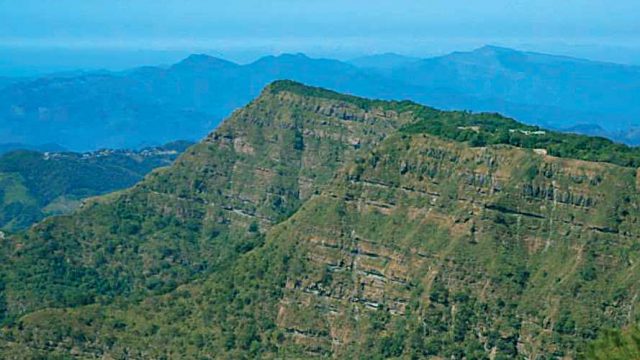The scenic village of Hmuifang, south of Aizawl, is perched atop the Hmuifang mountain. Blessed with gorgeous vistas and unspoilt natural beauty, the village is ideal for picnics, trekking or a simple leisure holiday. The hill range runs from north to south and most of its western side is very steep and presents quite a challenge if visitors are interested in pursuing rock climbing.
From here, one may also take a trek to nearby Mizo villages such as the Sumsuih (2km), Chawilung (5km), Thiak (6km), Maubuang (10km), Sateek (20km), Baktawng (30km) and Sialsuk (35km), to witness typical rural life in Mizoram. You could also ask the villagers to arrange for a folk dance performance. Trekkers are advised to contact villagers for guidance. There are many friendly villagers who have started homestays where you can taste local cuisine and get a glimpse of their daily life and culture.

Where To Stay
Tourism department’s Hmuifang Tourist Resort (Cell: 08131987689; Tariff: ₹600), located in the midst of nature, offers six double rooms and a cafeteria. Makeshift tents are also available for hire. While staying here, one can opt for biodiversity trekking, and explore the flora and fauna including the rare redneck keelback, a non-venomous snake, or trek down to River Changte. The resort staff will help you arrange treks and rock-climbing excursions.
You can even join Biodiversity and Nature Conservation Network (BIOCONE) an upcoming NGO based in Aizawl, involved in environmental protection and the maintenance of ‘Clean Mizoram’.
Around Humifang
Phawngpui (15km)
En route to Phawngpui you can spot the mighty Chhimtuipui river, flowing through the valley, the mountain ranges in Myanmar, and breathe in pine-scented air since the route is flanked by pine-laden grassy slopes. Bright seasonal flowers also cover these slopes which are dotted by charming wooden homes.
You could stop in between and walk alongside the river as you approach Phawngpui, which lies at an elevation of 2,157m.

Phawngpui is also called the Blue Mountain, which is considered the abode of the gods. Situated close to the state’s south-eastern border, the Phawngpui Blue Mountain National Park was established in 1992. The park is geographically located in the Lawngtlai District, towards the southeast of Mizoram. It offers enthralling views of the surrounding hills. The park’s floral combination includes several species orchids, rhododendrons and bamboos.
Animals such as the mountain goat, tiger, leopard, leopard cat, serow, goral, Asiatic black bear, stump-tailed macaque and capped langur also inhabit the park. Forest biologists spotted and documented the presence of the clouded leopard (Neofelis nebulosa) here for the first time in 1997. Birdwatchers will find a treasure trove of avian life here. The variety of birdlife in this park include Blyth’s tragopan, falcon, sunbirds, dark-rumped swift and Mrs. Hume’s pheasant, Mizoram’s state bird.
Timings Open for six months in a year. Best time to visit the park is during the months of November to April. For complete information on entry fee, entry timings etc, contact Directorate of Tourism, Government of Mizoram, Bungkawn Aizawl, Mizoram (Tel: 2333475/ 2335677, Email: mizoram.tourism@gmail.com)
Tip Carry a binoculars and a book on birds
Trekking Around Phawngpui
For a taste of Mizo rural lifestyle, one could trek or take a ride to Sangau village, the closest settlement before reaching Phawngpui.
During the course of the trek, one might be lucky enough to sight the goral, serow, sambar, leopard, hoolock gibbon, common langur or hear the call of barking deer.
For more info about wildlife in Mizoram, contact Principal Chief Conservator, Aizawl, Tel: 0389- 2325727 or Chief Wildlife Warden, Aizawl, Tel: 0389-2325371
Where to Stay & Eat
Visitors can avail the facilities in the rest houses in the Saiha area near the park. For bookings, contact Directorate of Tourism, Government of Mizoram, Bungkawn Aizawl, Mizoram (Tel: 2333475/ 2335677; Email: mizoram. tourism@gmail.com). It is difficult to find decent restaurants here. It is best to eat at your guesthouse or carry packaged food along
FAST FACTS
When to Go November–April; the park is open for six months in a year
Tourist/ Wildlife Offices
Director, Directorate of Tourism, Aizawl, Tel: 0389-2335690, 2335677
Chief Wildlife Warden, Aizawl, Tel: 2325371, STD code 0389
GETTING THERE
State Mizoram
Location At an elevation of 1,619m in the Aizawl District of Mizoram
Distance 50km SW of Aizawl
Route from Aizawl Take NH54 to Hmuifang
Air Aizawl’s Lengpui Airport (45km/ 1hr) is connected to Kolkata. A cab to town from here will charge about ₹1,300 for a drop
Rail Nearest railhead: Silchar (140km/ 6hrs). Independent Sumo taxi costs about ₹4,000; sharing ₹300–400 per head to Aizawl
Road NH37 and NH40 from Guwahati to Shillong; from Shillong take NH44 to Silchar via Jowai. From Silchar drive straight down NH54 (ends near Myanmar) to Aizawl via Sonaimukh, Kolasib and Mualvum Bus Private buses (along with Sumo taxis cost ₹11,000; sharing ₹1,100 per head) also serve the Guwahati-Aizawl route regularly. Take NH54 from Aizawl to Hmuifang (50km/ 1.5hrs). Local taxis (Sumos) cost between ₹1,500–2,000 per day for sightseeing




